2025 Pennsylvania Chapter Planning Awards
PA Chapter of APA congratulates this year’s Pennsylvania Planning Excellence Award recipients. These awards exemplify planners’ best efforts to create stronger, healthier, and more just communities.
Award for a Plan: Chester County Trail Planning Series
Chester County Planning Commission
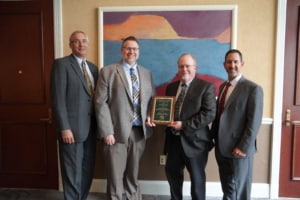 The Chester County Trail Planning Series represents an ambitious and exemplary body of work advancing a countywide vision for an interconnected trail network. Comprising four coordinated plans—the Chester Valley Trail Extension to Downingtown, Chester Valley Trail West, Southern Chester County Circuit Trail, and the Chester County Trails Master Plan—the series provides both detailed feasibility studies and a unifying framework to guide implementation.
The Chester County Trail Planning Series represents an ambitious and exemplary body of work advancing a countywide vision for an interconnected trail network. Comprising four coordinated plans—the Chester Valley Trail Extension to Downingtown, Chester Valley Trail West, Southern Chester County Circuit Trail, and the Chester County Trails Master Plan—the series provides both detailed feasibility studies and a unifying framework to guide implementation.
Together, these plans not only fulfill the Landscapes3 CONNECT goal of linking communities through trails, but also contribute to the regional Circuit Trails network and the Schuylkill to Susquehanna Statewide Major Greenway. Each plan was grounded in extensive public engagement, including multilingual outreach, interactive mapping, and strong partnerships with municipalities, nonprofits, and community advocates.
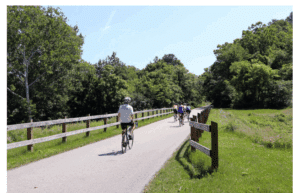
Chester Valley Trail
Already, the plans are catalyzing action: acquisition has begun on critical rights-of-way, municipalities are advancing catalyst projects, and additional funding has been secured. By integrating transportation, recreation, health, and environmental objectives, the Chester County Trail Planning Series demonstrates the power of visionary, inclusive, and implementable planning to create a healthier, more connected future.
The committee recognized the Chester County Trail Planning Series as a comprehensive and inclusive effort that goes well beyond traditional trail planning. By weaving together multiple plans into a cohesive vision, and by engaging a broad range of communities and partners, the series sets a strong foundation for long-term success. The committee was especially impressed by how quickly the work has moved from planning to implementation, with tangible progress already underway.
Award for a Plan: Building Community – Housing Vision Plan
First Presbyterian Church of Bethlehem
COLLABO Planning + Design
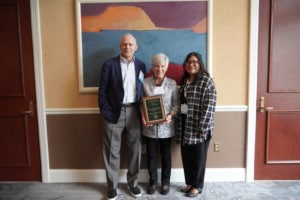 In 2023, the City of Bethlehem conducted a Housing Needs Assessment to better understand the key drivers of the city’s affordable housing challenges, the current and future housing needs of city residents, and opportunities to close the gaps. This assessment revealed shocking statistics about the reality many families in the city faced in accessing stable housing due to the high cost and low availability of rental housing. In response to this need, and the growing sentiment among church members and leadership that the church’s vast resources could better serve the community, First Presbyterian initiated a nine-month public planning process to develop a vision for utilizing its 124,000-square-foot building and 31.56-acre campus to meet the community’s critical housing needs.
In 2023, the City of Bethlehem conducted a Housing Needs Assessment to better understand the key drivers of the city’s affordable housing challenges, the current and future housing needs of city residents, and opportunities to close the gaps. This assessment revealed shocking statistics about the reality many families in the city faced in accessing stable housing due to the high cost and low availability of rental housing. In response to this need, and the growing sentiment among church members and leadership that the church’s vast resources could better serve the community, First Presbyterian initiated a nine-month public planning process to develop a vision for utilizing its 124,000-square-foot building and 31.56-acre campus to meet the community’s critical housing needs.
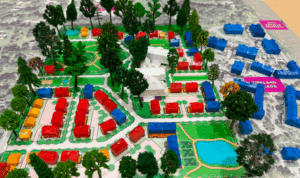
Initial Housing Concepts
The planning process included church members, surrounding neighbors, and other community stakeholders in developing a vision for what mixed-income housing and community amenities on First Presbyterian’s campus could look like. The planning team designed a planning process that was transparent, inclusive, and centered on building trust and capacity for the church’s intent to build long-term financial sustainability; to continue offering ministries of expansive welcome and serving its most vulnerable neighbors.

Residents at Community Meeting
The planning engagement included surveys, listening sessions, community meetings, intimate conversations with neighbors, a mass mailing of postcards, and door knocking on homes immediately adjacent to the campus. These extensive community engagement efforts contributed to the iterative development of a set of principles to guide the creation of the Housing Vision as well as design concepts. Eleven visions for the future of the campus were developed by the community at a design workshop in November 2023. Three design concepts emerged from the workshop visions. They were presented for community feedback at an open house in January 2024 and an online survey made available through March 2024. In May 2024, at an outdoor community event, the culmination of the feedback was revealed. The Housing Vision includes 200 mixed-income units built upon the natural features and beauty of the campus, clustering homes around amenities including playgrounds, community gardens, walking trails, and athletic fields. Fifty percent of the campus remains landscaped open space. Housing types include twins, townhomes, and small apartment buildings. The range of housing types provides a healthy community with a balance of opportunities for a wide range of families and households.
Implementation of the Housing Vision over the next several years will allow the church to retain ownership of its property and pursue development as a joint-venture partner to ensure the vision is implemented as intended. The realization of this Housing Vision will have a significant, positive impact on the Bethlehem community.
Award for a Project, Program or Practice: Pocket Guide to Active-Transportation-Friendly Code
Montgomery County Planning Commission
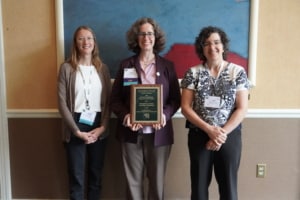 Many municipalities strive to support the health and wellness of their residents by providing safe areas for walking, bicycling, and other healthy activities. Oftentimes, the municipalities provide these safe locations with large infrastructure projects, such a parks, trails, and walking paths. These types of facilities are all fantastic and are often desired, welcomed, and heavily used by residents.
Many municipalities strive to support the health and wellness of their residents by providing safe areas for walking, bicycling, and other healthy activities. Oftentimes, the municipalities provide these safe locations with large infrastructure projects, such a parks, trails, and walking paths. These types of facilities are all fantastic and are often desired, welcomed, and heavily used by residents.
Municipalities may, however, have a gap between the safe spaces that they’d like to provide for walking and bicycling and the spaces that their development codes require. The Pocket Guide to Active Transportation-Friendly Code aims to help municipalities reduce that gap. The Guide emphasizes the importance of integrating active transportation into local codes to support community wellness. In particular, the Guide addresses a variety of elements and standards that should be included in the Zoning Ordinance or Subdivision and Land Development Ordinance, focusing on ways to require developers to contribute to the pedestrian and bicyclist network during the land development process.
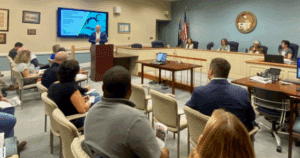
Audience and panel of speakers at the October 2024 Planning Smarter Event, Can I Get There From Here? Connecting Communities with Active Transportation
This document was created by the Montgomery County Planning Commission in conjunction with the Pennsylvania WalkWorks program and its director Samantha Pearson. While Montgomery County released the document primarily for its municipalities, the Guide is relevant state-wide and easily usable by any
Pennsylvania city, borough, or township. The document’s abbreviated nature makes it an approachable and quick read for any municipal official interested in updating their codes. Similarly, the Guide’s compact form makes it easier to use menu-style, choosing elements that a municipality identifies as a good fit for their community.
Demonstrating the desire for straightforward and accessible guidance, the Guide has gone through several print runs and has been requested and distributed state-wide. It serves as a model for planners to provide their expertise in a format that municipal officials and the general public welcome and use.
Award for a Project, Program or Practice: Transit Oriented Communities Guidelines
Southeastern Pennsylvania Transportation Authority (SEPTA)
 SEPTA’s Transit Oriented Communities (TOC) Guidelines are a groundbreaking planning document for the Authority that redefines how SEPTA engages with communities, local governments, and regional stakeholders to promote equitable, walkable, and transit-supportive development. The Guidelines provide the foundation for SEPTA’s TOC program and justify SEPTA’s participation in land use, zoning, and development as a stakeholder, landowner, developer, and advocate.
SEPTA’s Transit Oriented Communities (TOC) Guidelines are a groundbreaking planning document for the Authority that redefines how SEPTA engages with communities, local governments, and regional stakeholders to promote equitable, walkable, and transit-supportive development. The Guidelines provide the foundation for SEPTA’s TOC program and justify SEPTA’s participation in land use, zoning, and development as a stakeholder, landowner, developer, and advocate.
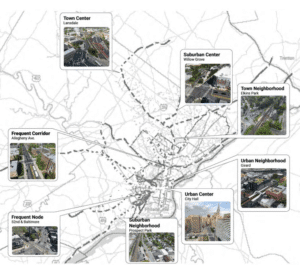
Typologies visualize the TOC strategies
The Guidelines are built around a typology of station areas and corridors, with tailored recommendations for land use, access, public realm design, and housing. They emphasize that TOC is context-sensitive, shaped by transit frequency, multimodal access, and community character.
SEPTA’s TOC Guidelines represent a shift in how transit agencies can approach land use. Rather than reacting to outside development proposals, SEPTA is using the Guidelines to lead growth around its system. SEPTA is already participating in zoning remapping, local code reform, and regional housing advocacy.
These elements are already translating into action. SEPTA is implementing TOC at demonstration sites in Ambler and Germantown and conducting planning at multiple others. By grounding TOC in agency operations and prioritizing implementation from the outset, the Guidelines are helping the agency generate long-term lease revenue and increase ridership potential through land use reform and equitable, mixed-use development.
These results show that the Guidelines are both timely and impactful; already delivering measurable results for SEPTA and the region. They equip SEPTA and its partners with the tools to respond to urgent challenges, housing affordability, climate resilience, access to opportunity, and to do so in a way that centers equity, walkability, and long-term community benefit.
Award for a Leader – Distinguished Service: Brian O’Leary (Retired)
Chester County Planning Commission
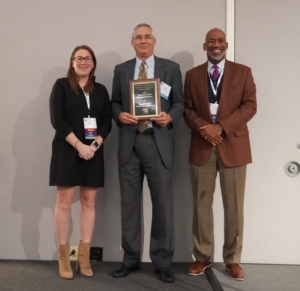 Brian retired from the Chester County Planning Commission at the end of 2024 and leaves an impressive legacy of planning excellence in the county and the region. Brian was a strong planning partner working with municipalities, PennDOT, SEPTA, and many other agencies and stakeholders.
Brian retired from the Chester County Planning Commission at the end of 2024 and leaves an impressive legacy of planning excellence in the county and the region. Brian was a strong planning partner working with municipalities, PennDOT, SEPTA, and many other agencies and stakeholders.
Following his 28-year tenure at the Montgomery County Planning Commission, Brian became the Executive Director of the Chester County Planning Commission in 2015. Brian led the update of Chester County’s award-winning comprehensive plan, Landscapes3, which received the National Association of County Planners Award of Excellence for a Comprehensive Plan, and the Pennsylvania Chapter of the American Planning Association Award for Plans.
Brian served for 10 years on the Lower Merion Township Planning Commission where he persevered through long meetings lasting past midnight, gaining first-hand experience and sympathy for all local planning commission members. Brian also served on the Delaware Valley Smart Growth Alliance Board for over a dozen years and on the Board of Health Spark, an organization that supports community empowerment and leadership.

Brian makes a new friend on Chester County farm tour
During Brian’s time at CCPC, the county was the recipient of 17 awards for excellence in areas ranging from comprehensive planning to smart transportation to planning outreach. Brian is a longtime member of the Pennsylvania Chapter of the American Planning Association (APA PA) and served as the president for four years. He volunteered his time and efforts to the organization in multiple capacities. He served for 20 years on the APA PA Chapter Awards Committee, including seven years as the Committee Chair. Brian also served as the APA PA Chapter Southeast Section Chair for four years.
More recently, Brian served on the Tri-County Passenger Rail Committee and then the Schuylkill River Passenger Rail Authority. Brian was a founding SRPRA Board Member, the Chair of SRPRA’s Marketing and PR Subcommittee and a vital member of the Technical Committee, comprised of the Planning Directors from Chester, Montgomery and Berks Counties and their lead Transportation Planners.

